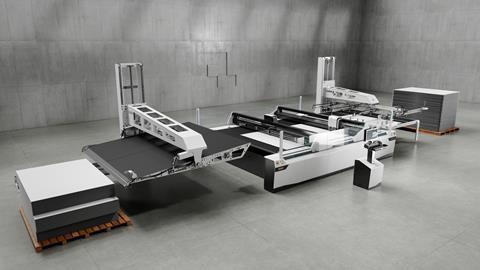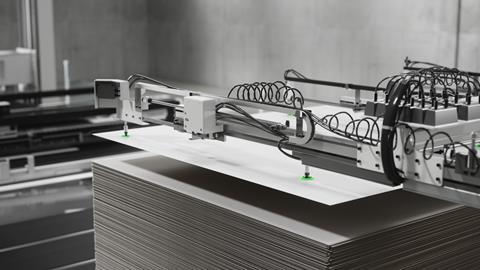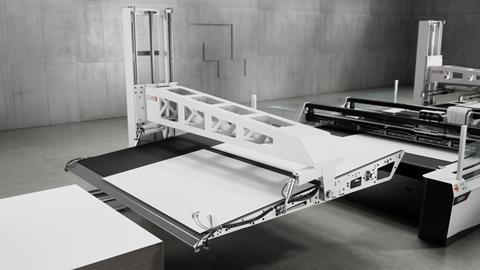
On the 19th-20th April modular cutting systems provider Zünd held a press event in Altstätten, Switzerland for the launch of its new Q-Line cutter with BHS180 board handling system, created to address “a customer base that needs a productive and highly automated machine on an industrial level” according to Oliver Zünd, who opened the event. Frances Butler reports.
On display was the new Q-Line cutter with the BHS180 board handling system and ‘UNDERCAM’ , an integrated system solution intended to meet the demands of highly automated, industrial finishing for printed boards in displays and packaging. It can be used for a variety of materials including corrugated and un-corrugated cardboard.
A closer look at the new cutter
Aleks Lazic, segment manager of packaging at Zünd elaborated on the details of the cutter, which offers 2.1g acceleration and up to 2.8 metre per second speed aiming to reduce the cost per unit, waste, downtime and improve equipment efficiency. He emphasised that the Q-Line “does not replace the 3rd generation [of cutter] – rather, the two generations complement each other.” There are 3 different sizes of cutter from 1.8 x 3.2 metres up to 3.2 x 3.2 metres, together with the BHS180 system. The UNDERCAM is integrated into the system’s board feeder and captures board edges, register marks and QR codes for job identification (if the boards are print side down).
Why was the Q-Line created? “It is our response to the increase in customer demand for a highly automated complete solution in industrial pallet-to-pallet production in shift or multi-shift operations,” Lazic stated. “With this product bundle, we are targeting POS (point of sale) and packaging manufacturers where minimum manpower and maximum output are required.”
He explained the cutter has a mineral cast base and a fibre reinforced beam designed to reduce total weight and absorb emerging forces. The system is apparently equipped with completely automated tool management; there is a tool changer for up to 7 tools which allows automatic tool changing during operation without needing to stop the machine, and a ‘tool backup’ feature which means multiples of the same tool can be installed for “uninterrupted operation”.

Speaking to Frances Butler, Lazic said the company is also responding to the increase in demand for unattended digital cutting. “A day has 24 hours. The more you can utilise these hours to create value, you earn more. There’s no system which can run forever, as it depends on the operator. The operator is affecting the efficiency and creating value in these 24 hours.”
He added that Zünd hope to “make it as easy as possible for the operator to “press a button, let it run, and the machine is so smart and intelligent by itself that you can use those 24 hours.”
In terms of savings in energy efficiency and production, “due to the performance levels we have – 2.1g acceleration and 2.8 metres per second speed – we can cut faster. Since we can cut faster, we reduce the cost per unit.”
He also said the automated aspects of the tool changer, UNDERCAM and QR codes “increase the availability and the overall equipment efficiency”, with the QR codes also reducing waste and downtimes.
How the Q-Line and BHS180 work in operation
Segment manager of graphics, Lars Bendixen, explained the Q-Line user experience. The cutter comes with a touchscreen workstation which includes the Zünd Cut Centre software. He pointed out the red and green lights displayed on each corner of the cutter, allowing the operator to move around the machine during operation. He added that the system can be used in a multi-machine environment as a central point can be used to manage all tools, meaning the operator can be elsewhere in the factory during operation. There is also an option to set up email alerts to the operator’s phone in case there are any issues.
Bendixen demonstrated that when adding tools, the operator can use a scanner to inform the system which blade has been scanned. Once all the required tools and knife blades have been scanned, a list can be created with the Cut Centre software. He also stated the machine will automatically process everything it has tools for.

Outlining the operation process, Bendixen said once the axis rotation has been checked, the boards are loaded onto the table, where laser modules capture the edges. If some of the boards are out of alignment, they can be re-aligned during the loading process. The board is then pushed down onto the glass plate (to avoid shadows in the board if using corrugated cardboard, for example).
The cutter can process sheets for multiple jobs, as each new job will be unloaded at the end of the process in a different position, to distinguish one job from another within the same stack. If the UNDERCAM cannot read the QR code on a board, it will be processed without cutting and unloaded in a different position to the rest of the sheets.
What are the company’s future plans following the launch of the new cutter? Aleks Lazic informed us that “down the road there are a lot of improvements we have to do. We want to develop [the Q-Line] to get more efficiency out of it, as we did with our third generation.”
However, he says Zünd also “have to think about what happens before loading and after loading. One example is that after cutting, you must get rid of the waste. Today this is done manually. I’m convinced that we’ll find a solution for this and create value for the customer.”

















No comments yet